Press Release
These are some of the experiences of our students during their studies in the Master's Program "Human Biology - Principles of Health and Disease"! Enjoy!
Insights into the research project of Manasvini Sridharr "Fibrinogen uptake in cancer cells: good or bad?"
Insights into the research project of Jonas Huber "Balancing Act: Axon Health in MS"
Insights into the Master Thesis of Mengxin Wu "Mechanisms of migratory cDC1 in tumors"
Insights into the Master Thesis of Güney Güvenç "Treating Cardiac Arrhythmia"
Insights into the research project of Clemens Steinek "A simulation of early development"
What can our students expect in their 1st semester?
Luise Schröger and Frederike Schäfer at the Nobel Prize Dialogue in Berlin!
Anja Domadenik at the MIT in Boston for the iGEM Jamboree
Start of the second cohort of the Elite Master Program „Human Biology“
Start of the new Elite Master Program „Human Biology"
2024, Effect of Fibrinogen uptake on the expression of HMGB1 in different cell lines
Insights into the research "Fibrinogen uptake in cancer cells: good or bad?" by Manasvini Sridharr
Introduction to PDAC - Pancreatic Ductal Adenocarcinoma
Pancreatic ductal adenocarcinoma (PDAC) accounts for more than 90% of pancreatic cancers and develops in the exocrine compartment of the pancreas. Surgery and chemotherapy can improve the survival of patients at the early stage of the disease; however these interventions in patients with late stages of the disease are often unsuccessful and the formation of distant metastases remains a challenge, as this constitutes the main cause of death in PDAC. The poor prognosis in PDAC patients is also often associated with delayed diagnosis and resistance to conventional therapies due to the immunosuppressive tumor microenvironment. The tumor microenvironment of PDAC is characterized by its multifaceted nature, involving dynamic interactions among neoplastic cells, stromal cells, inflammatory immune cells, myeloid-derived suppressor cells, and extracellular matrix proteins. Additionally, PDAC is associated with a hypercoagulable state, contributing to an elevated risk of venous thromboembolism. Fibrinogen has been proposed as a potential biomarker in the serum of PDAC patients compared to healthy subjects. Fibrinogen plays an important role in blood clotting and inflammation. Thrombin released from activated endothelium and platelets cleaves fibrinogen to fibrin, further inducing clot formation and recruitment of inflammatory immune cells. In line with elevated levels of fibrinogen, a strong deposition of fibrin was described in PDAC tumor tissues compared to normal pancreatic tissues. Although fibrin(ogen) levels were found elevated in advanced tumor stages in many solid cancer types, including PDAC, the molecular mechanisms of fibrinogen uptake and release remain elusive.
Aim of the study: The fibrinogen uptake capacity between normal pancreatic epithelial and PDAC cells
In this study, the fibrinogen uptake capacity between normal and PDAC tumor cell lines was analysed, using mouse and human PDAC, as well as normal pancreatic cell lines (HPDE, KPC and Panc1). Interestingly, a significant enhancement in FGN uptake in cancer cells was observed, highlighting the potential regulatory role of oncogenic pathways in this uptake mechanism. This research indicates that fibrinogen uptake mechanisms are differentally regulated between normal and pancreatic cancer cells, which may influence the fibrin(ogen) levels during cancer progression and metastasis, thereby modulating the response to the anti-cancer treatments
Future perspectives
Future studies will decipher the underlying molecular mechanisms, including the kinetics of fibrinogen uptake and release during PDAC tumor growth and progression. Additionally, the study will analyze the contribution of the uptake process to several hallmarks of tumor cells, including invasion, inflammatory cell recruitment, cytokine release, blood clotting and resistance to the anti-cancer therapies in PDAC.
2024, Calcium-mediated mechanisms in the autoimmune disease multiple sclerosis.
Insights into the research "Balancing Act: Axon Health in MS" by Jonas huber
Can calcium be a promising target for MS therapies?
Calcium plays many critical roles in the nervous system. It is for instance involved in synaptic transmission, neuronal plasticity, and cellular signaling - important neurological mechanisms. Unfortunately, in the autoimmune disease MS, calcium levels are elevated inside axons, which can lead to breakage of important neural connections. The focus of Huber's internship was to contribute to the ongoing research question on whether buffering calcium levels can prevent that axonal degeneration.
The Kerschensteiner lab works with an established mouse model, in which MS can be simulated. These mice are called EAE mice. EAE stands for experimental autoimmune encephalomyelitis. In his internship, Huber established protocols for immunohistochemistry stainings of central nervous system tissue of those mice.
With such a staining, protein expression can be visualized. He aimed to determine, whether a previously induced overexpression of calcium-binding proteins was successful, and if that overexpression could have neuroprotective effects by removing excess intra-axonal calcium.
Looking at MS under the microscope
Next to protein expression studies, the laboratory uses state of the art microscopy techniques to visualize the progression of axonal breakage in MS. With transgenically fluorescently labeled axons, spinal cords of deeply anesthetized EAE mice can be imaged for several hours. Within that time, the axons can break or stay healthy. As mentioned above, calcium seems to play a critical role in that transition. Huber started with the analysis of those data to help better understand what could contribute to the maintenance of healthy axons in MS. The question on whether buffering calcium levels within the axon has a neuroprotective effect, has not finally been answered. It will be continued by his colleagues.
December 2020, Mechanisms that regulate the development and functionality of migratory cDC1 in tumors.
An Abstract from the Master Thesis of Mengxin Wu
Orchestration of cancer immunity
Conventional type I dendritic cells (cDC1) play a crucial role in the initiation and regulation of anti-cancer immunity. A key step for cancer immunity is the migration of cDC1 to tumor-draining lymph nodes, where cDC1 initiate cancer immunity by presenting tumor associated antigens to so-called cytotoxic T cells. Mengxin Wu’s master project aims to understand the mechanisms that regulate the development and functionality of migratory cDC1 in tumors.
Understanding the development of migrator cDC1
In her first experiments, Mengxin established a tumor-cDC1 coculture system that allows to generate different migratory and non-migratory cDC1 populations in vitro. Mengxin used this model to test the impact of variable experimental conditions, tumor cell-derived factors as well as proinflammatory mediators, on the development of migratory cDC1. In these experiments, she uncovered that neither the availability of tumor cell antigens nor the duration of tumor cell-cDC1 interaction were a major determinant for the migratory potential of cDC1. Rather, specific inflammatory mediators commonly released by cancer-associated cells, so-called cytokines, induced the development of migratory cDC1.
The meaning of the investigation
This work identifies novel pathways that regulate the ability of cDC1 to exit the tumor tissue and migrate to lymph nodes. Based on Mengxin’s findings, future studies will investigate how these pathways might be exploited to promote cDC1-mediated cancer immunity for cancer therapy.
Mengxin Wu is a former student of the Elite Graduate Program “Human Biology – Principls of Health and Disease”, she finished her Master thesis within a Junior Research Group “Local immune control of cancer within the tumor microenvironment” funded by the Elite Network of Bavaria.
Learn more about the Elite Graduate Program Human Biology: https://www.mhb.uni-muenchen.de/index.html
Learn more about my research at the Institute of Molecular Immunology and Experimental Oncology: http://www.imi-muenchen.de/research-groups/boettcher/research-group-boettcher.html top
November 2020, Treating Cardiac Arrhythmia
An abstract from the Master Thesis of Güney Güvenç
A new option to treat cardiac arrhythmia
Cardiovascular diseases are the top reason for death, and arrhythmia is the reason for the most sudden cardiac deaths, but the treatment options are limited due to the severe side effects of antiarrhythmic drugs. Güney Güvenç, a former student of the
Human Biology - Principles of Health and Disease Elite Master Study, translated his mitochondrial biology knowledge into biomedical research to aim in extending the indication of two FDA approved drugs as a novel treatment option in arrhythmia.
Targeting mitochondria to cope with arrhythmia
The pathophysiology of many cardiac diseases, including cardiac arrhythmia,
originates from the misregulation of calcium homeostasis. With every heartbeat, the cytosolic
calcium concentration inside cardiomyocytes raises to induce contraction and declines to allow muscle relaxation. One prominent mechanism to shape calcium signaling in the cell is the mitochondrial calcium uptake via mitochondrial calcium uniporter complex (MCUC).
It was recently demonstrated that enhancing mitochondrial calcium uptake is a promising strategy to suppress heart muscle cells' arrhythmogenesis. However, the lack of druggable compounds that modulate the MCUC is the main challenge to further developing this strategy. In the preliminary study, more than 700 FDA and EMA approved drugs had been screened, and two drugs were found as strong candidates to be substances that enhance mitochondrial calcium uptake. These two candidates (MiCUps) are in the market to treat different diseases. Nevertheless, proving their effect on enhancing mitochondrial calcium uptake and enlightening the molecular mechanism of them in this content are required to extend their indications to treat also arrhythmia.
How MiCUps enhance mitochondrial calcium uptake
Güney investigated the molecular mechanism of these two FDA-approved drugs, which are strong candidates to be MCUC modulators (MiCUps) and, as such, could act as antiarrhythmics in addition to their current uses. To test the first hypothesis that MiCUps increase mitochondrial calcium uptake by increasing the mitochondrial membrane potential instead of directly acting on mitochondrial calcium uniporter complex (MCUC), he recorded the mitochondrial membrane potential on different cell lines. Güney has demonstrated that MiCUps could affect the mitochondrial membrane potential. However, an analysis of CRISPR/Cas9-induced MCUC subunit based knockout cell lines indicated that this increase is rather a consequence than a cause for enhanced mitochondrial calcium uptake. His data indicated that increased mitochondrial membrane potential is not the cause of the enhanced mitochondrial calcium uptake with MiCUps.
After he eliminated the first hypothesis, he investigated a potential direct role of the drugs on the MCUC. He measured drug-induced changes in calcium uptake in cell lines selectively deficient for individual MCUC subunits using an aequorin bioluminescence-based assay.
Güney established a protocol that successfully reproduced the enhanced calcium uptake observed in the presence of MiCUps. In the absence of the MICU1 subunit of MCUC, these drugs could not show an effect. That might indicate that MiCUps target the MICU1 subunit of MCUC.
In summary, his study could strengthen the clinical relevance of these two MiCUps to treat cardiac arrhythmia; moreover, if required, drugs’ chemical structures could be modified considering their possible interaction with the MICU1 subunit of MCUC to extend their indications.
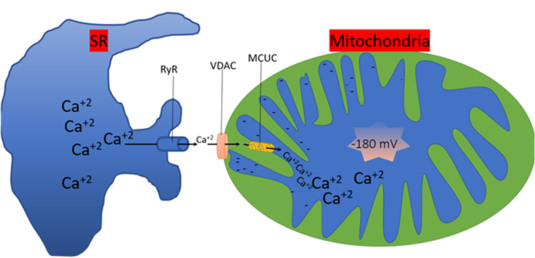
© Güney Güvenç
Cardiac arrhythmia is caused by the misregulation of calcium handling. During the fast transfer of calcium from sarcoplasmic reticulum (SR) to mitochondria, MiCUps look like acting on a specific subunit of MCUC, increasing mitochondrial calcium uptake and restoring arrhythmia.
Learn more about the Elite Graduate Program Human Biology - Principles of Health and Disease:
https://www.mhb.uni-muenchen.de/
Learn more about “The heart lab”, Gudermann/Schredelseker Lab "Cardiac Pharmacology":
https://www.en.wsi.med.uni-muenchen.de/resarch_groups/general-pharma-toxicology/schredelseker-lab/index.html top
September 2020, Insights into research „A simulation of early development“
Research Project – Clemens Steinek, Elite Graduate Program „Human Biology – Principles of Health and Disease“
Creating embryo-like structures in Petri dishes
The appearance of embryos changes dramatically during early development. In order to study this spectacular period of life in an ethically responsible manner, Clemens Steinek, a former student of the of the Elite Graduate Program “Human Biology -Principles of Health and Disease”, aims to re-create embryonic structures in the laboratory.
The fascinating world of early development
Early development is accompanied by remarkable changes in the size and shape of embryos. Shortly after conception, the fertilised egg undergoes rapid cell division, thereby forming a symmetrical ball of cells. In a process called gastrulation, stem cells within the ball of cells move extensively and are transformed into three different types of cells (ectoderm, mesoderm, endoderm). These three cell types will give rise to most parts of the adult animal. While ectodermal cells will form the central nervous system, mesodermal and endodermal cells will establish muscles and the outer lining of the gut, respectively. Although the underlying processes of early development are of great biological importance, it is often difficult to study mammalian gastrulation due to ethical concerns. To overcome this challenge, scientists have developed different techniques through which developmental processes can be mimicked in the laboratory. Recently, a new milestone in the simulation of early development has been achieved with the generation of gastruloids. Gastruloids areorganised stem cell aggregates which seem to undergo gastrulation. Since gastruloids are novel systems to study early development scientists have yet to determine all possible applications.
What can we do with gastruloids?
Clemens Steinek aimed to observe when and where ectodermal, mesodermal and endodermal cells arise in gastruloids. In his first experiments, he modified murine embryonic stem cells using CRISPR/Cas9 technology to allow the visualisation of all three cell types. Over the past years, CRISPR/Cas9 has emerged as a reliable and powerful tool to edit the genetic information of organisms. In principle, the Cas9 protein is transported to specific locations in the genome where it provokes breaks of the double-stranded DNA. While the cell attempts to repair the damaged DNA, additional DNA can be provided which is then integrated into the genome. In this manner, different genes can be fused which lead to the production of proteins with new characteristics. If an ectodermal-specific gene is combined with a fluorescent reporter gene, then ectodermal cells will exhibit bright colours under the microscope. Based on this mechanism, Clemens Steinek genetically modified stem cells and observed the formation of ectodermal, mesodermal and endodermal cells in gastruloids. Remarkably, the spatial distribution of all three cell types was highly organised. This work provides a foundation for further studies and sheds light on early developmental processes.
Remarkably, the spatial distribution of all three cell types was highly organised. This work provides a foundation for further studies and sheds light on early developmental processes.
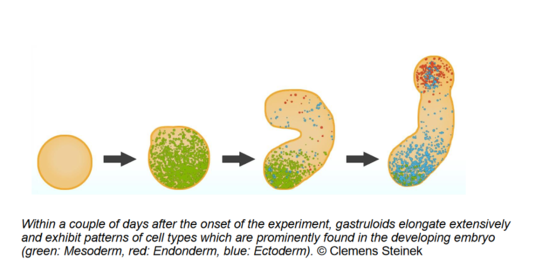
© Clemens Steinek
Within a couple of days after the onset of the experiment, gastruloids elongate extensively and exhibit patterns of cell types which are prominently found in the developing embryo(green: Mesoderm, red: Endonderm, blue: Ectoderm). top
December 2019, Courses of the Program of the new Elite Master Program „Human Biology – Principles of Health and Disease“
The first semester of the elite master’s program „Human Biology – Principles of Health and Disease“ aims to enlarge and deepen existing know-how gained from the previously completed Bachelor’s program. After the first semester, the students will be prepared with practical skills for more specialized courses in the main topic areas.
Highlights of the first semester
Equipped with their own „lab book“, the students have already attended their first five mandatory modules within their first semester. Three of them are „Methods in Biomedical Sciences“, „Computational Biology“ and “Model Organisms”.
The module “Methods in Biomedical Sciences” covers the most commonly used methods of molecular biology based on the exemplary nuclear protein PCNA, which plays an important role in a range of essential processes such as DNA replication and DNA repair. The students are not only asked to apply standard molecular techniques, but are also challenged to understand and scrutinize the underlying principles and biology. To complete their understanding of molecular biology, the course „Methods in Biomedical Sciences” is embedded in the “Computational Biology” course, that directly prepares for the wet lab course on the one hand and on the other hand allows meaningful interpretation and evaluation of data obtained during the course.
The course “Model Organisms” provides basic knowledge and skills in the use of different model organisms for disease research. The students learn how to handle seven different model organisms from ß-cell-lines to mouse models using for each organism a different experimental design. The studied diseases were among others diabetes, hypertension, asthma, and lung fibrosis.
Please visit the following website for more information about the Elite Master’s Program: www.mhb.lmu.de.
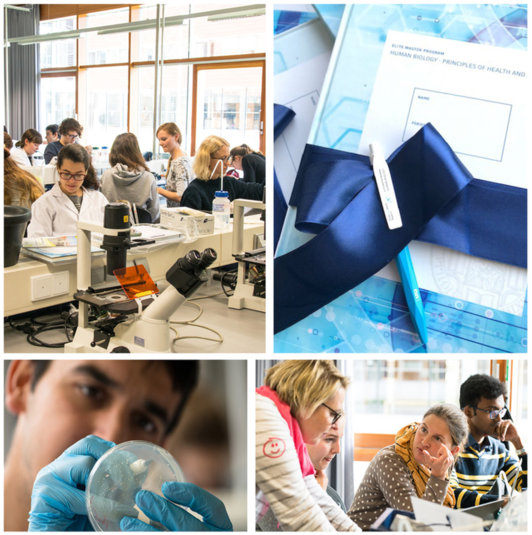
© Carolin Bleese - Faculty of Biology - LMU Munich top
08.11.2019, Nobel Prize Dialogue – Towards Health
The Nobel Prize Dialogue is an annual conference, which should improve the public communication between scientists and the rest of the society. This year, in 2019, it took place in Berlin with the topic “Towards Health – Equality, Responsibility and Research”. On the occasion of current pandemics, increasing numbers of patients suffering from tumors or neurodegenerative diseases and other medical problems, it was discussed how the global health status can be enhanced.
Discussing global health from several perspectives
Two students of the Elite Graduate Program „Human Biology – Principles of Health and Disease” got the unique chance to participate in the Nobel Prize Dialogue in Berlin on the 8th November 2019. The trip was sponsored by the Elite Network of Bavaria as an award for the best presentation in course of a seminar about Nobel Prizes, which were awarded because of their high medical importance. This seminar is part of the main module „Microbiology, Infection and Immunology“.
Four Nobel Laureates discussed together with other world-leading scientists and politicians the current status of global health and several aspects affecting it.
- Who is responsible for health? – Yourself, the politicians of your country, researchers?
- How does the climate change affect global health?
- What is the role of our microbiome?
- How can yourself contribute to global health and achieve a healthier life?
- Those are some examples of the questions that were arising and heavily debated in short presentations, open discussions and lunchtime conversations.
Listening, reflecting problems and participate
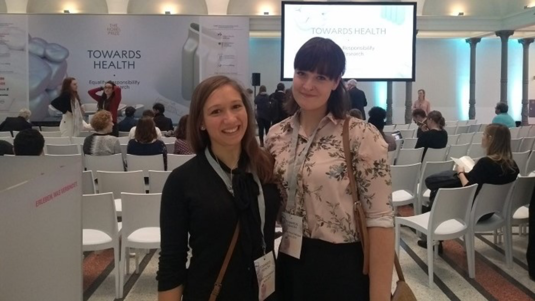
© Frederike Schäfer
Two students of the Elite Master Program “Human Biology – Principles of Health and Disease” participating in the Nobel Prize Dialogue 2019 with the topic “Towards Health – Equality, Responsibility and Research”.
During the podium discussions and presentations, the auditorium was not able to participate or asking questions. However, these sessions encouraged to self-reflect the arising problems and think about possible connections and solutions. On the other hand, everybody could introduce his or her own thoughts and questions as a part of the lunchtime conservations and discussions in the afternoon.
It was highly impressing to get inputs from different scientific, sociological and political fields which were combined to a wide and highly connected network of aspects influencing the global health. The Nobel Prize Dialogue is a great event to give scientists a general overview of results in other scientific fields but also to inform the non-scientific society. Together, we all try to create a connecting platform that moves the global society towards health.
Text: Luise Schröger, Elite Graduate Program "Human Biology – Principles of Health and Disease" top
01.11.2019, iGEM München 2019
Students have been developing a novel diagnostic tool with potential to monitor transplanted cells in vivo.
iGEM competition, where exciting new SynBio projects come to life
The iGEM (international Genetically Engineered Machine) competition is an annual event, full of creative SynBio projects developed by student teams. It was founded in 2003 by the Massachusetts Institute of Technology (MIT) and has since pursued the goal of getting young teams of scientists from all over the world enthusiastic about diverse and daring projects.
Anja Domadenik, a student of Elite Graduate Program „Human Biology – Principles of Health and Disease“, has been one of iGEM LMU and TU Munich Team 2019 members, presenting the proof of principle for their diagnostic tool in 3 different cell lines. They have been nominated not only for Best Diagnostics but also Best Basic Part and Best Entrepreneurship award. Theoretical and practical knowledge Anja has gained through her first year of Human Biology Master’s program, has revealed extremely valuable for her to apply to this project. Not only that, the program gave her great motivation to advance in her scientific development and think outside the box.
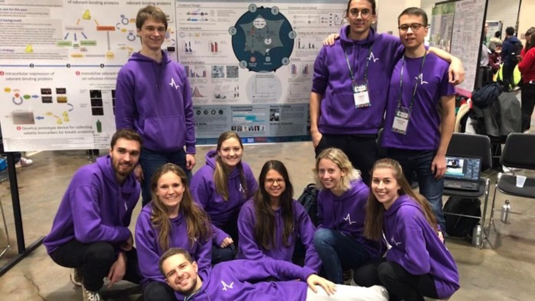
© Annika Elimelech
Exchanging ideas and gaining a new perspective
More than 300 student teams from all over the world participate on iGEM competition every year, competing for awards from different categories, ranging from e.g. Best Presentation to Best Software. This year, each team presented their project and discussed its strengths and weaknesses during several poster sessions in Boston (MA). In addition to that, several workshops and booths have been organized by different companies, offering their knowledge and career advice.
iGEM Team Munich 2019 have developed an exciting new method for monitoring transplanted cells with the help of vesicles. With it, specific RNA-level information can be packed into vesicles and exported outside cells, ready to be analysed. The main vision behind the advantages this method could bring into a diagnostics field, relies in the ability to perform diagnostics on living cells. On the last day, the competition has been concluded by final team presentations on a big stage, where winners of all categories have finally been revealed.
iGEM competition, being a strong networking event, presents itself as a lively research and start-up environment, being a springboard for more than one successfully developed biotech company. Anja has described iGEM as an unforgettable opportunity for students to meet new people, to get an overview on current topics in science and therefore broaden their horizons.
Text: Anja Domadenik, Elite Graduate Program "Human Biology - Principles in Health and Disease" top
07.10.2019, Start of the second cohort of the Elite Master Program „Human Biology – Principles of Health and Disease“
Welcome Day for the new students
The first year of the second cohort of the Elite Master’s program „Human Biology – Principles of Health and Disease“ began in October 2019 after a highly competitive admissions procedure. The Elite Master of Science is an interdisciplinary, research and competency-oriented program that provides a deep understanding of mechanisms and principles in health and disease.
Students from all over the world
Twenty-one highly motivated students from eleven different countries all over the world have started the program. On October 7th, the students met for the first time at the Biocenter of LMU Munich. After an introduction to the study program, the students decide to organize a joint excursion in the Bavarian mountains to get to know each other better and to see the place where they will spend the next two years
The students took the train with final destination the lake "Tegernsee", from there it was a 14 km walk to the lake Schliersee. With bright sunshine and a light blue sky, the students exchanged information continuously; made breaks, exchanged culinary delights and thus felt like members of a common group at the end of the day.
Get started
The next day after the excursion, the program commenced with an introductory course that allows students to brush up on the lab skills, which are needed during the Master’s program. This ensures that everybody, regardless of the institution they came from, will be optimally prepared for the lab courses. Additionally, all students, both national and international, have already had the opportunity to attend the international communication skills workshop. The workshop deals with the new challenges of a multicultural academic environment.
Beside the curriculum the students gladly accepted the Elite Network’s invitation to the „Get-together“ event. They got a lot of information about the offers of the Elite Network Bavaria and took the change to get in contact with other people across subject boundaries. They are all looking forward to the next steps and events of the study program.
Please visit the following website for more information about the Elite Master’s Program www.mhb.lmu.de
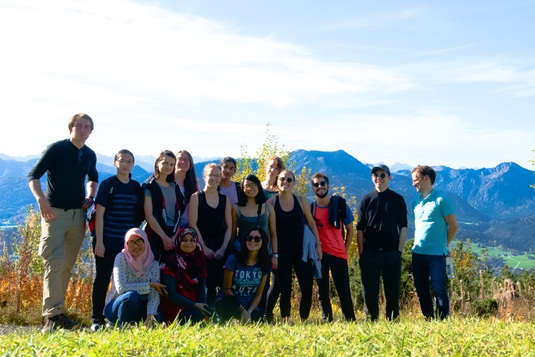
© Victor Kreiner top
15.10.2018, Start of the new Elite Master Program „Human Biology – Principles of Health and Disease“
The first year of the new Elite Master’s program „Human Biology – Principles of Health and Disease“ began in October 2018 after a highly competitive admissions procedure. The Elite Master of Science is an interdisciplinary, research and competency-oriented program that provides a deep understanding of mechanisms and principles in health and disease.
Students from all over the world
Twenty-four highly motivated students from ten different countries all over the world have started the program. After only a short time on the program, students have described themselves, among others, with the following hashtags "#multiculti", "#hardworking", "#family", "#teamPlayers" and "#learnalot".
The program commenced with an introductory course that allows students to brush up on the lab skills which are needed during the Master’s program. This ensures that everybody, regardless of the institution they came from, will be optimally prepared for the lab courses. Additionally, all students, both national and international, have already had the opportunity to attend the international communication skills workshop which was organized by the Office of Intercultural Counseling of the LMU. The workshop deals with the new challenges of a multicultural academic environment.
The students gladly accepted the Elite Network’s invitation to the „Get-together“ event, and they are all looking forward to the next steps and events of the study program.
Please visit the following website for more information about the Elite Master’s Program: www.mhb.lmu.de.
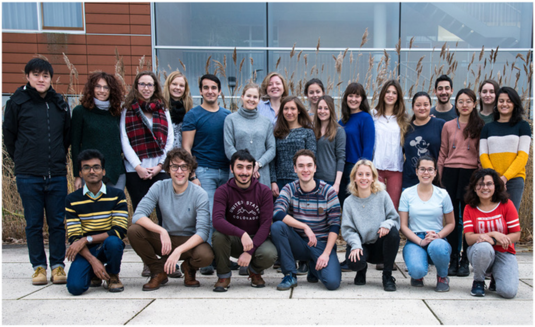
©: Carolin Bleese - Faculty of Biology - LMU Munich

